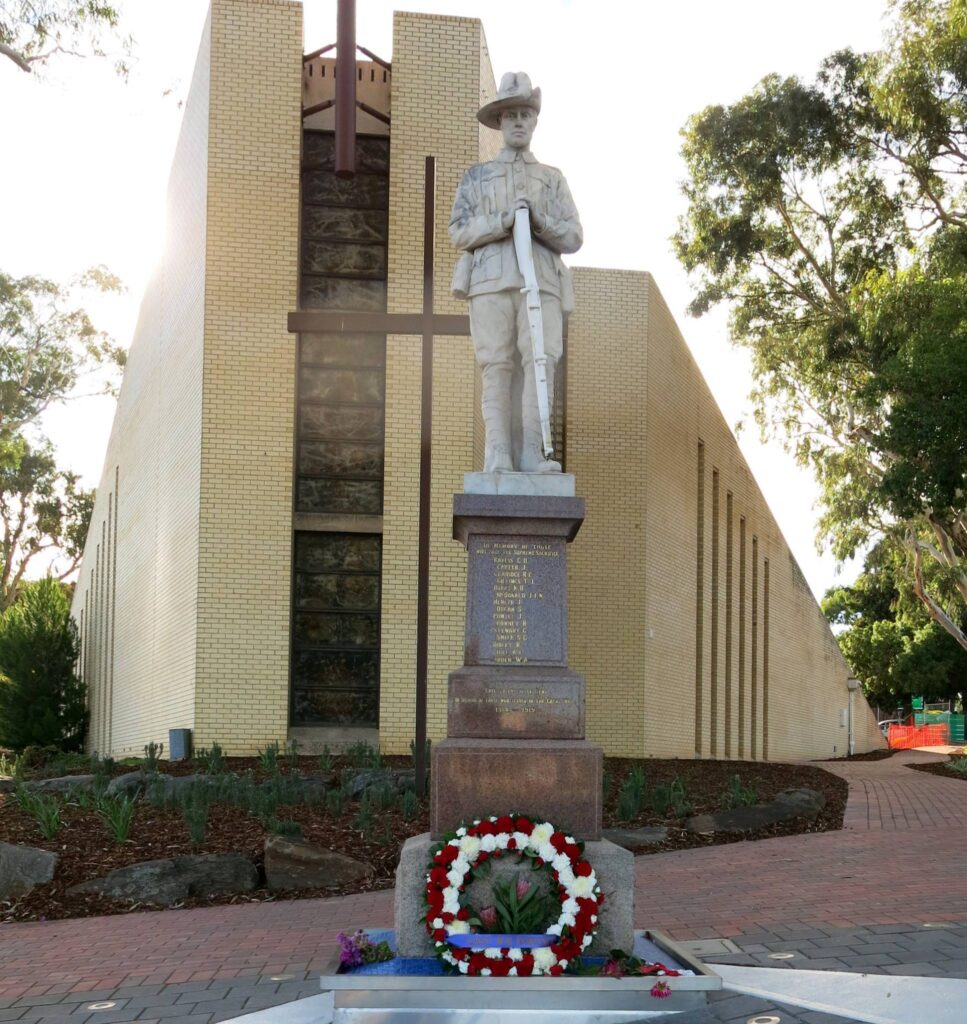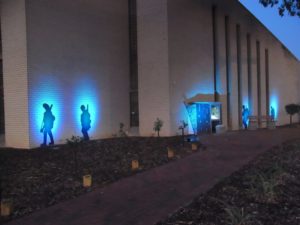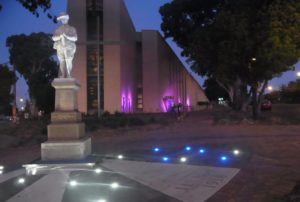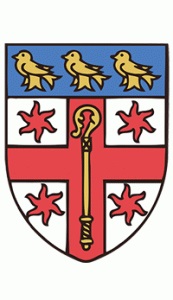St Martins Heritage Walk
St Martin’s Heritage Walk includes the Soldiers’ Memorial and the Anzac Soldiers’ Walk. The Memorial was erected in 1925 and the pathway in 2015.
Soldier's Memorial
The official unveiling of the monument occurred in July 1925 to commemorate those who served in the First World War (1914-1918).
More than 415,000 Australians volunteered for service during the ‘Great War’ and of those there were more than 60,000 deaths and many more were injured. There are 94 names listed on the War Memorial of those who served from the Campbelltown Council District, including a special panel dedicated to the 14 who did not return.
It is a white marble statue of a soldier standing at “Rest on Arms Reversed” with left hand over right and the rifle muzzle on left boot, mounted on a polished red granite three-tier pedestal that in turn is mounted on a granite block surbase and concrete slab. All details are in gold leaf.
The memorial was unveiled on Sunday 5 July 1925 by Brig.-Gen. S. Price Weir DSC VD, with these words: “To the glory of God and in sacred remembrance of the 14 soldiers from this town and district, who, in the world Great War, made the supreme sacrifice, I unveil this monument.” Followed by two minutes silence.
Brig.-Gen. S. Price Weir “congratulated those responsible for the memorial on the magnificent site they had chosen. Being at the junction of two important roads, in front of a church, and on church property, part of which was a cemetery, the surroundings were in perfect keeping with the idea.”
The Memorial was originally located on a traffic island at the junction of Lower North East Road and Gorge Road and included a horse trough which was later removed when road widening occurred in the 1960’s and the monument was moved to its current location. The monument has historical significance, not only as it lists the names of those who served and those who perished, but also because of its location at the front of the St Martin’s Church and Cemetery where relatives of many of the soldiers listed are interred. The Memorial is also significant, not only as a reminder of the local district’s commitment to Australia’s involvement in the First World War, but also as a place that was valued as a gathering site for locals on ANZAC Day over many generations.
The Digger on the Campbelltown Soldiers’ Memorial lost his marble rifle to peace protesters during the Vietnam War (1962 – 1975). A fibreglass replica, cast by local monumental masons Schubert and Son, replaced the original marble rifle in 1991, as part of extensive repairs to the war memorial.
Since the unveiling of the Campbelltown Soldiers’ Memorial in 1925 there have been a number of attempts to relocate it, due to increasing road traffic, but local residents have consistently favored the memorial remaining in its present location.

ANZAC SOLDIERS’ WALK
In 2014 the idea of a special ‘walk’ along the southern side of St Martin’s church was suggested by the priest Reverend Canon Mara Di Francesco who wanted an area of solitude where people could spend time in reflection. At about the same time, the Federal Government announced it was introducing local grants (Australian Government Anzac Centenary Local Grants Program) to commemorate the 100th Anniversary of the beginning of World War 1 and the start of the ANZAC “Digger” traditions. For many years local services have been held on Anzac Day (25th April) and Remembrance Day (11th November)
In 2015, (the 100th Anniversary of the Gallipoli landing) the monument and surrounds were upgraded by the Campbelltown City Council (partly funded by the Anzac Grants program. The landscape upgrade was carefully designed to enhance the surrounds and reflect on some of the history of the Memorial and its location at this site. The works include the use of blue tiling on the top of the concrete base to symbolically reflect the horse trough that was originally located at the base of the statue. The LED upward-shining beams embedded in the grey slate pavers were introduced to the site to represent the stars in the night sky and include five blue beams representing the Southern Cross.
St Martin’s also applied for a grant under the program and received funding to install the new pathway plus a number of other features reflecting on the battles fought and the difficult conditions our “Diggers” had to face. It also identifies some of the significant sacrifices made by our soldiers while fighting and dying in foreign countries in support of their ideals and the “mother country”.
Significant Symbols along the ANZAC Walk include:
- An Avenue of 12 standard rosebushes where each rose along the pathway represents a major World War 1 battle in which Australian soldiers fought and covers the three major theatres of the war – Gallipoli, the Western Front (Western Europe) and the Middle East (Egypt and surrounding areas).
- A symbolic trench wall, topped with sandbags to provide a stable edge and some protection from bullets, which incorporates:
- a metal book giving details of the soldiers from the district and other relevant details
- an interactive push-button information system relating eight different stories about WW1 .
- Four silhouettes of soldiers are mounted on the church wall with two reflecting the reinforcements coming up to replace those lost on the battlefield and two more on the Memorial side reflecting those already involved going up to support the soldier on the Memorial. The silhouettes are floodlit at night in a display of varying colours which enhance the feature and tie in with the new lighting around the Memorial.
- The rosemary bushes planted directly behind the Memorial have a particular significance for Australian soldiers as rosemary was found growing wild on the Gallipoli Peninsula. A sprig of rosemary is commonly worn by soldiers on ANZAC Day and placed on the coffins of deceased soldiers by other soldiers attending the funeral as a “we will remember them” gesture.
- Sandbag seats have been used along the walk to symbolise the shortage of everything we currently take for granted. The soldiers were forced to use anything that was available and sandbags were one of those things available as they were light and could be easily transported.
The official opening of both the ANZAC Walk and the World War 1 Memorial upgrade took place on Saturday 14th November 2015 and involved many of the families, relatives and friends of the soldiers named on the memorial as well as representatives of Federal, State and Local Government. It was a true celebration of the Centenary of all the gallant ANZACs from the Campbelltown area.


